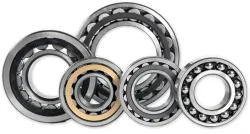Types of roller bearings
2023-11-29
Roller bearings are another category of rolling-element bearings that use cylindrical, tapered, spherical, or needle-shaped rollers to support and reduce friction in rotational or linear motion. These bearings are commonly employed in various industrial applications due to their ability to handle heavy loads and provide high radial or axial load capacities. Here are some common types of roller bearings:
1. Cylindrical Roller Bearings:
- Cylindrical rollers are used in these bearings, and they have high radial load capacity.
- Suitable for applications with high radial loads, such as in machine tools and electric motors.
2. Tapered Roller Bearings:
- Tapered rollers are arranged in a way that their axes converge at a point on the bearing axis.
- Ideal for applications where both radial and axial loads need to be supported, such as in automotive wheel hubs and gearboxes.
3. Spherical Roller Bearings:
- Spherical rollers allow these bearings to accommodate misalignment and axial loads in addition to radial loads.
- Commonly used in heavy-duty applications, such as in mining and construction equipment.
4. Needle Roller Bearings:
- Needle-shaped rollers are used in these bearings, and they are suitable for applications with limited radial space and high loads.
- Commonly used in automotive transmissions and aircraft components.
5. Thrust Roller Bearings:
- Designed to support axial loads and are equipped with either cylindrical, tapered, or spherical rollers.
- Common applications include heavy-duty machinery and equipment.
6. Cam Followers:
- Roller bearings designed specifically for applications where the bearing follows a cam profile.
- Commonly used in cam mechanisms, indexing and conveying equipment.
7. Spherical Plain Bearings:
- Utilize spherical inner and outer rings to accommodate angular misalignment.
- Commonly used in applications requiring oscillating or tilting motions, such as in hydraulic cylinders.
8. Track Rollers:
- Designed for applications where the bearing follows a track or rail.
- Commonly used in conveyor systems, cam drives, and linear motion applications.
9. Crossed Roller Bearings:
- Have cylindrical rollers arranged in a crossed pattern between inner and outer rings.
- Suitable for applications requiring high precision and rigidity, such as robotics and machine tools.
10. Thrust Cylindrical Roller Bearings:
- Similar to thrust ball bearings but use cylindrical rollers.
- Suitable for applications with heavy axial loads.
Roller bearings offer various advantages, including high load-carrying capacity, durability, and the ability to handle shock and impact loads. The specific type of roller bearing chosen depends on the application's requirements, such as load type, speed, precision, and environmental conditions.



